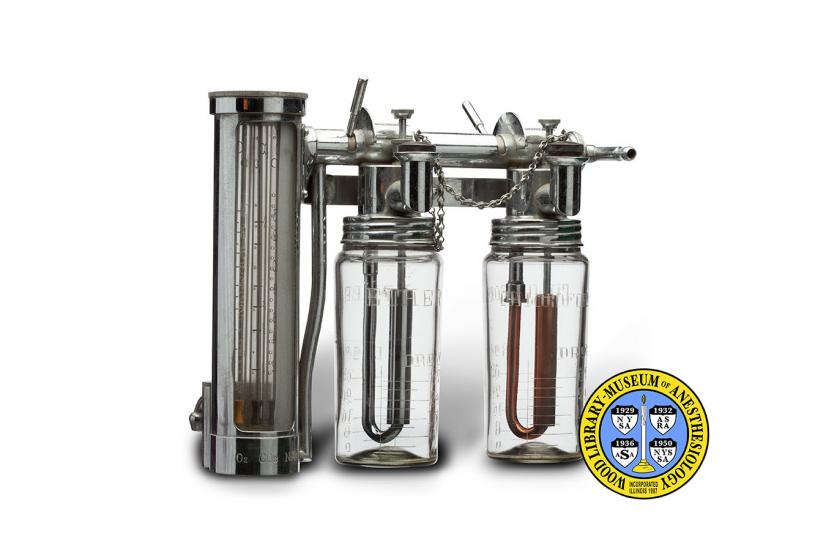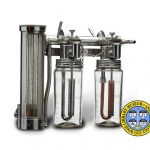Boyle Bottle
The 1911 Cotton-Boothby Apparatus incorporated a "bubble through" or "sight feed" mechanism. It provided the first visible indicator of the amount of anesthetic being administered. The gases and ether vapor were routed through a perforated tube in a glass mixing chamber containing water. The rate of flow could be estimated by observing the force of the resulting bubbles in the water. A similar sight feed bottle was part of the 1912 Gwathmey-Woolsey Apparatus, made by the Foregger Company of New York.
The leading English anesthetist Dr. Henry E. G. Boyle (1875-1941) invented a nitrous oxide, oxygen and ether machine in 1917. It was based on the Gwathmey-Woolsey apparatus, and made by Coxeter & Sons of London. The Boyle Machine was used by British forces in World War I. Coxeter later became part of the British Oxygen Company, the dominant manufacturer of anesthesia machines in the United Kingdom. Boyle's sight-feed apparatus therefore became a standard feature of British anesthesia machines. It was widely known as the Boyle Bottle. Shown here is a vaporizer array made by Coxeter in the 1920s. It includes a Boyle bottle chloroform vaporizer, an Boyle bottle ether vaporizer, and flowmeters for the gases oxygen, carbon dioxide and nitrous oxide.
Catalog Record: Boyle Bottle
Access Key: akno
Accession No.: 2006-03-27-4
Title: [Boyle’s Gas-Oxygen Apparatus.]
Corporate Author: Coxeter.
Title variation: Alt Title
Title: Boyle Bottles.
Title variation: Alt Title
Title: Coxeter vaporizer array.
Title variation: Alt Title
Title: Coxeter flowmeters and Boyle bottles.
Title variation: Alt Title
Title: Vaporizer and flowmeter assembly / Coxeter.
Title variation: Alt Title
Title: Coxeter Boyle gas anaesthesia apparatus.
Title variation: Alt Title
Title: Boyle’s apparatus.
Publisher: London : Coxeter ; [1931-1937].
Physical Descript: 1 vaporizer and flowmeter assembly ; metals, glass, plastics, rubber : 25 x
28 x 13.5 cm.
Subject: Anesthesia, Inhalation – instrumentation.
Subject: Ether, Ethyl.
Subject: Chloroform.
Subject: Vaporizers.
Subject: Flowmeters.
Note Type: General
Notes: The early year on the date range for the possible year of manufacture is
based on the publication date for the patent number marked on the top of the
flowmeter case. The late date is based on the year that Rotameters replaced
the bobbin flowmeters (Thomas, 1975). The date range could change if
documentation indicates it should be corrected.
Note Type: General
Notes: The title comes from the earliest publication found in which the version of
the Boyle Apparatus described here is described and named (the 4th edition of
Handbook of Anaesthetics by Ross and Fairlie).
Note Type: Citation
Notes: Ball C, Westhorpe R. The Coxeter Boyle gas anaesthesia apparatus. Anaesth
Intensive Care. 1999;27(2):129.
Note Type: Citation
Notes: Dorsch JA, Dorsch SE. Vaporizers. Understanding Anesthesia Equipment:
Constructrion, Care and Complications. Baltimore: Williams & Wilkins
Company:1975:99-104.
Note Type: Citation
Notes: Hewer CL. Recent work on the ethers. Recent Advances in Anaesthesia and
Analgesia (Including Oxygen Therapy). 3rd ed. Philadelphia: The Blakiston
Company; 1939:90-92.
Note Type: Citation
Notes: Ross JS, F HP. Nitrous oxide and oxygen. Handbook of Anaesthetics. 4th ed.
Baltimore: William Wood & Company; 1935 :91-94.
Note Type: Citation
Notes: Thomas KB. The nitrous oxide series. The Development of Anaesthetic Apparatus
Oxford: Blackwell Scientific Publications; 1975:145-151.
Note Type: Citation
Notes: Watt M. The evolution of the Boyle apparatus 1917-1967. Anaesthesia. January,
1968;23(1):103-118.
Note Type: Citation
Notes: Wellesley G; Coxeter & Son, Ltd. Improvements in or relating to apparatus for
measuring the flow of gases. United Kingdom Patent 347,467. Application date
April 14, 1930. Publication date April 30, 1931. IPEXL: Intellectual Property
EXchange Limited website. https://patent.ipexl.com/GB/347467ZZDASHZZA.html.
Accessed December 19, 2013.
Note Type: Citation
Notes: Wellesley G; Coxeter & Son, Ltd. Improvements relating to apparatus for
administering anaesthetics. United Kingdom Patent 258,454. Application date
December 18, 1925. Publication date September 23, 1926. IPEXL: Intellectual
Property EXchange Limited website. https://www.directorypatent.com/GB/GB258454
html. Accessed December 19, 2013.
Note Type: Physical Description
Notes: One vaporizer and flowmeter assembly, with two vaporizers and three
flowmeters housed in one case; The cylindrical case for the flowmeters
measures approximately 23 cm in height and 6 cm in diameter; Three curved
ports extend from the back of the base of the flowmeter case; The inner
flowmeters are of the bobbin type and are labeled for “O2”, “CO2”, and “N2O”;
The top of the flowmeter case has the following manufacturer markings,
“COXETER’S [new line] FLOWMETER [new line] PATENT [new line] No. 347467”; A
bar for the vaporizers extended from the upper right side of the flowmeter
case; On the bar, at each vaporizer bottle connection, is a lever with a
semicircular plate marked with the following reference points, “ON”, three
graduation marks, and “OFF”; Manufacturer markings on the bar include,
“PATENT NO. 258454 [new line] 331050 [new line] COXETER [new line] LONDON;
The ether vaporizer bottle is closest to, or just right of, the flowmeter
case; The inlet tube for the ether vaporizer is stainless steel;
Markings on the ether bottle include, “ETHER [new line] DRMS”; Below this are
graduation marks from 0 to 32; Every other graduation mark is numbered; The
numbered marks are 0, 8, 16, 24, and 32; The chloroform vaporizer is similar
to the ether vaporizer except the inlet tube is copper (or brass) and the
bottle is labeled “CHLOROFORM”. Each vaporizer, bottle only, measures
approximately 15 cm in height and 6.5 cm in diameter at the base;
Note Type: Reproduction
Notes: Photographed by Mr. Steve Donisch on June 11, 2013.
Note Type: Historical
Notes: This is a 1930s iteration of what is generally referred to as a Boyle
Anesthesia Apparatus. The first Boyle Apparatus was introduced in 1917 by Dr.
Henry E. G. Boyle (1875-1941), a leading English anesthetist. It was based on
the Gwathmey & Woolsey Apparatus, and an apparatus designed by Sir Geoffrey
Marshall during WW I. This first Boyle apparatus had one ether vaporizer, and
one water “bubble through” or “sight feed” flowmeter, in which the rate of
the flow of the gases was estimated by observing the speed and force of
bubbles blown into water.
Around 1930 the vaporizers used with Boyle Machines incorporated the u-shaped
inlet tubes with adjustable caps or hoods, and around 1931 the bubble through
flowmeter was replaced with a dry flowmeter. Both of these are features of
the apparatus described here.
Vaporizers in the line of Boyle Anesthesia Machines came to be called Boyle
Bottles. These vaporizers had valves to adjust the flow of carrier gas into
glass bottles that held a liquid anesthetic, such as ether or chloroform. The
gas was directed through a u-shaped inlet tube. How the gas flowed out of the
tube was controlled by a plunger and hood that covered the opening of the
inlet tube. If the plunger was up, the gas exited the end of the inlet tube,
above the surface of the anesthetic. If the plunger was in the down position,
the hood forced the gas to bubble up through the liquid anesthetic.
Note Type: Publication
Notes: Boyle EG, Wellesley G. The anaesthetic equipment in the new surgical block at
St. Bartholomew’s Hospital. Br J Anaesth. Br J Anaesth. April,
1930;7(3):130-134.
Note Type: Publication
Notes: Discussion on anaesthesia in intracranial surgery. Proc R Soc Med.
1933;26(8):953–958. (Boyle apparatus with a dry-flowmeter is mentioned on
page 957: ” … with any gas-oxygen-ether apparatus available-Boyle’s, with
dry flow meter, being that of choice.”).
Note Type: Exhibition
Notes: Selected for the WLM website (noted December 22, 2013).


